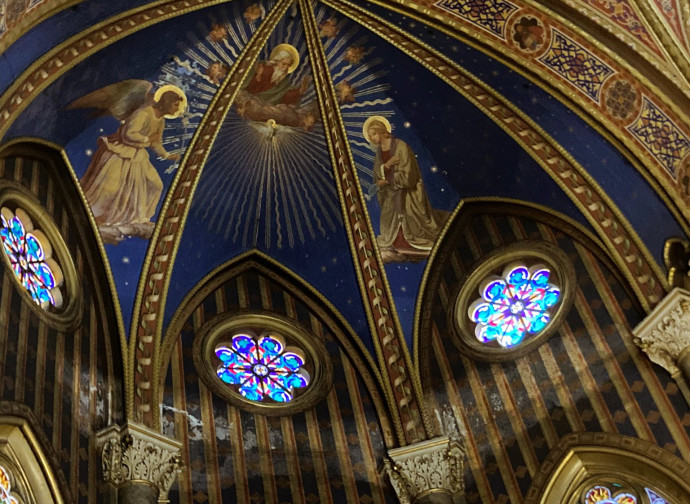What is above: encountering God through beauty
Helping people rediscover the way up to Heaven through the paths of art and creation. This is the goal that prompted an American student to expand an idea born during the months of lockdown.

Seek What Is Above is a project focused on the beauty of art and creation, to remember the ultimate destination - eternal beauty - in an age that has stopped looking upwards. It is therefore not only a cultural interest, but also an opportunity for personal and spiritual growth, that has prompted Margaret Peppiatt, a senior theology student at the Franciscan University in Steubenville, Ohio, to expand and share an idea born during the months of lockdown, as she told The Compass.
Why can art and beauty in general be a path to God?
The project began with realizing how much sacred art of the Gospel there was that people weren't seeing. Children's bibles have illustrations, but what about all these other works of art that both children and adults could benefit from? By perceiving the beauty of sacred art through our exterior vision, we are free to turn our interior gaze on God and "let the word of Christ dwell in us richly," as St. Paul says (Col 3:16). The artwork merely helps us focus on the Scripture even more closely.
Can nonbelievers also be touched by the beauty that springs from faith?
Yes, even nonbelievers can be touched by the beauty that springs from faith! Every human person has the capacity to be touched by beauty in some way, whether that is through paintings, songs, plays, or another medium. Beauty is rooted in God, Who is Beauty Himself. Art that is truly beautiful, for of course in our fallen nature we can corrupt it, could lead nonbelievers to consider that God may in fact exist. For example, sacred art presents Christ not as a distant being but a real person who wants to personally love and save them.
When did the Seek What Is Above project start?
My project was born during the first months of the pandemic in the spring of 2020. At first, I began working on The Gospel with Sacred Art without planning to publish it on my own. After completing the project over two years later, I decided to start my own business to publish the book. I chose the name "Seek What Is Above" based on an English translation of Colossians 3:1-2 ("If then you were raised with Christ, seek what is above, where Christ is seated at the right hand of God. Think of what is above, not of what is on earth”). My mission is to encourage people to lift their minds and hearts to God through exposure to truth, beauty, and goodness.
In the book The Gospel with Sacred Art, what criteria guided your choice of certain works, periods, or artists?
I was limited in selecting paintings by two main factors: image resolution and copyright laws. Besides that, I tried to include a variety of artists and eras. The paintings span 6 centuries and feature artists from over a dozen countries. The artists include some famous names like Van Gogh, Rembrandt, and Leonardo da Vinci, as well as lesser known painters who nevertheless made significant contributions during their time. The variety of paintings attests to the timelessness of the Gospel, which has inspired artists throughout the centuries to create beautiful artwork based on the life of Christ.
A somewhat 'provocative' question: can we say that while Christian art of past centuries is still able to speak to us, contemporary art often misses the mark?
Yes, I agree with your view. Sacred art made within the last few decades is scarce compared to previous centuries, and very little of it conveys beauty and sacredness. I think this reflects the situation of modern culture, which seeks to distance itself from the Creator. Beauty reminds people of God, Who is Beauty Himself. People today do not want to be reminded of God, so is it any surprise that our art often lacks beauty? God was still part of past cultures that produced beautiful Christian art, such as the Renaissance. That is why such art can speak to the heart in a way that modern art often cannot.
Besides The Gospel with Sacred Art are there any other projects in the pipeline?
Yes, I am hoping to work on other projects with the same goal in mind: to help people encounter God through beauty. I also just made a selection of sacred art on the Rosary.
Is there a particular work that could sum up this message?
I would choose the painting on the cover of my book, Christ Appearing to Mary by Albert Pinkhkam Rider. Just like the resurrected Christ calls Mary Magdalene by name, He also calls each one of us by name. Jesus desires to have a personal relationship with us, and reading the Gospel opens our eyes to this truth. Sacred art that depicts scenes from the Gospel echoes this individual call to know and love Christ.
A final word on the patron saint of the entire project…
I chose Karol Wojtyla, or Pope Saint John Paul II, as the patron saint and intercessor for my endeavor. We know that Wojtyla loved beauty because he loved the arts and nature. Wojtyla wrote plays and poetry, and he also loved spending time outdoors in God's creation. I hope to spread a similar love for beauty as found in art and creation.




